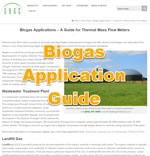In an earlier post, I discussed how the acid rain problem led to the advancement of the thermal mass flow meter in the 1990s. At the time, there was a need for continuous emissions monitoring of SO2 and NOx. Another period in the product’s brief history where environmental issues furthered the product’s progression was when the EPA implemented the greenhouse gas reporting program (GHGRP 40 CFR Part 98) in response to global warming.
In the market for a mass flow meter?
Greenhouse Gas and Global Warming

The worldwide acceptance of global warming has influenced manufacturers to respond to application challenges involving greenhouse gas emissions. For years, global warming has been a theory. Now that it is proven scientifically, regulations worldwide have been implemented to reduce greenhouse gases. The United States Methane Emissions Reduction Action Plan focuses on cutting pollution in the U.S. from significant sources of methane emissions.
Our white paper, Greenhouse Gas Emissions Monitoring Using Thermal Mass Flow Meters, contains a wealth of knowledge regarding greenhouse gas emissions and regulations, including the Kyoto Protocol, Certified Emission Reductions (CER), and the Greenhouse Gas Reporting Program.
As industries strive to reduce GHG emissions, thermal mass flow meter manufacturers were challenged to respond to regulations. As a result, new technologies and product breakthroughs have emerged, including the Sage Metering In-Situ Calibration.
EPA Greenhouse Gas Reporting Rule Calibration Requirements
The EPA Greenhouse Gas Reporting Rule requires frequent calibration checks for flow meters. The SAGE thermal mass flow meter user can quickly and conveniently verify the meter is in calibration with its In-Situ Calibration. The Sage calibration verification can easily and inexpensively be performed in the pipe, saving time and money from removing the meter and returning it to the factory for periodic re-calibration. Sage was the first manufacturer to offer an easy way to verify that the meter was accurate while still in the field. This development permits the use of the Sage meter in several greenhouse gas applications.
New Applications for Thermal Mass Flow Meters
Some applications that have brought new opportunities to thermal mass flow meter manufacturers because of the regulations include:
Biogas Measurement

Biogas is a byproduct of decomposition through anaerobic digestion and can be used to produce renewable energy. Because alternative energy must be generated to attain energy independence and meet greenhouse gas protocols, measuring and monitoring biogas is essential.
Ethanol Production
Thermal mass flow meters are used in ethanol production to measure air flow, fuel gas, and waste gases to optimize process productivity and reduce emissions. Read More >
Flare Gas
Thermal flowmeters can measure and monitor flare gas in various systems, including landfill gas, biogas, and natural gas.
Flue Gas Monitoring
The EPA requires flue gas monitoring for industrial processes for environmental reporting, and thermal flow meters offer a reliable way to monitor the gas. Read More >
Landfill Gas Monitoring and Recovery
Landfill gas (LFG) comes from municipal solid waste, and when used to create alternative energy, it indirectly reduces greenhouse gas emissions. Read More >
Methane Monitoring in Coal Mines
Coal mine ventilation systems and degasification require sampling. EPA regulations require the flow rate and methane concentration from each ventilation shaft.
If you want to learn more about how Sage Metering can assist you in your environmental application, call today at 866-677-7243 or visit thermal flow meters to help with environmental applications.

